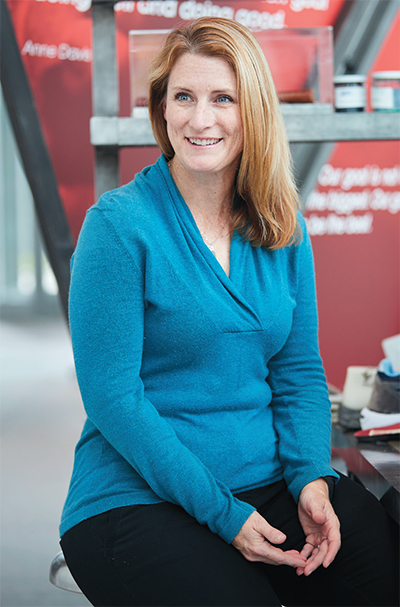
“The conversations with the students are insightful,” Renzi said. “(They) engage and have a lot of questions about my career, the work we do, and life outside of school.”
CLTP convenes local professionals, alumni, and other individuals looking to give back for several hours on multiple days during the spring and fall semesters. Coaches receive an overview of intended outcomes for students, and are instructed to observe and provide one-on-one feedback as students analyze case studies and work to solve a business ethics problem.
While coaching, Renzi accentuates self-reflection and self-awareness. In the past, she has helped students improve everything from body language to their problem-solving ability.
“Going through [coaching] as a student, I found the conversation with my coach incredibly beneficial,” Renzi said. “I wasn’t aware of what I was doing in some cases. Having objective feedback from someone who was interested in giving it, rather than waiting to get into a challenging situation, was really helpful.”
Renzi worked in financial consulting before joining New Balance in 2006. She has held a variety of roles at the company during the past 13 years and now serves as the head of strategy for the Direct to Consumer division. She started working with CLTP shortly after graduating and participates annually.
“To be successful, the program requires a lot of coaches,” she said. “I know my volunteerism, including the hours I’m putting in, has a large impact on the Babson community.” – Bryan Lipiner
]]>
As the world and workplace rapidly evolve, the need for education and ongoing learning will continue to increase in tandem. The essential and growing need for knowledge is a bright spot for colleges and universities during a period of disruption in higher education. It also presents a unique opportunity for Babson to capitalize on our strengths and extend our leadership in entrepreneurship education. The future of work requires that we dynamically solve problems and forge opportunities to create social and economic value.
Babson, across all phases of the learning continuum, educates entrepreneurial leaders who are nimble, opportunity-driven, innovative, and growth-oriented. They are collaborative problem-solvers who possess qualities and skills that make them particularly valuable in a fast-paced and constantly changing marketplace.
Babson recently announced a groundbreaking collaboration with The Arthur M. Blank Family Foundation to advance and amplify values-driven entrepreneurial leadership on a global scale. Through a $50 million gift, the largest ever awarded by the Blank Family Foundation and the largest single gift in the College’s history, Babson will establish the Arthur M. Blank School for Entrepreneurial Leadership. The development of this new school within the College requires all Babson disciplines to lead change, solve problems, and create sustainable value across business and society.
At the start of our second century, this is a major investment in the role of entrepreneurial leadership to improve the human condition. Babson has long been ranked No. 1 in entrepreneurship education, and this gift generates unparalleled energy and momentum for our continued leadership and innovation. Our strategic plan and the vision of Arthur M. Blank ’63, H’98—both of which we will explore in detail in our next issue—solidify Babson’s position at the forefront of the field.
The world is changing. Entrepreneurial leaders are more important than ever. Babson College has an important role to play, and we are envisioning and investing in concrete ways to create ongoing value for our community.
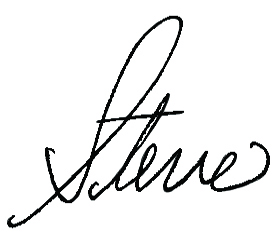
Stephen Spinelli Jr. MBA’92, PhD
]]>Since then, Kerry Healey was named the first female president in 2013, and Marla Capozzi MBA’96 first female chair of the Board of Trustees in 2017. The Centennial undergraduate class of 2019 was the first to have a female majority. In September, women from the first decade of graduating classes will return to the College as the Pioneering Women of Babson, partnering with the Center for Women’s Entrepreneurial Leadership to support current and future students and alumnae and inspire engagement and donations.
We asked some of these women to share their memories of campus and to offer advice to women students today.
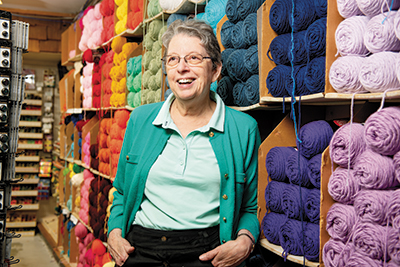
Carolyn Levosky MBA’69
Photo: Webb Chappell
Carolyn Levosky MBA’69
The first woman to earn a master’s degree
“These were changing times, but I still thought it was very brave of Babson to accept women. It was a bit experimental on their end, but I’m sure they saw the trends. The MBA students were a little older, and very welcoming, very open-minded.
“I was not trying to prove anything. When I graduated, they put my picture on the front page of The Boston Globe. It was a very big event. But I was just trying to do a good job for the next group of women, and I was glad to be early in the game. I think the writing was on the wall that women were going to go to graduate school and into the workforce in a big way.”
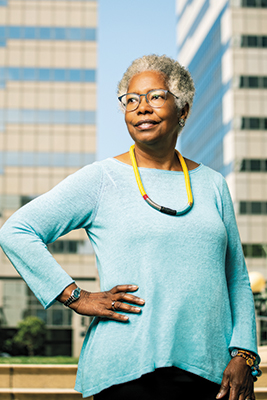
Sharon Rowser ’74
Photo: Winni Wintermeyer
Sharon Rowser ’74
“I was offered a full scholarship, and Babson showed a lot more interest in me than other schools I applied to. The civil rights movement was happening during that time, and colleges were reaching out to bring more minority students in, so I knew I was part of that. There was definitely a sense in those days that you were representing your people. A lot of single-sex schools were becoming coed then. What was more startling was how small the African-American population was. I was the only African-American woman in the school my first year. It’s complicated, and a bit emotional, too; it made me feel pretty alone, even though in high school it wasn’t unusual for me to be in classes with few African-Americans. Freshman year was the hardest, and it was definitely the living and social parts that made it hard. I felt I was as smart as everyone else, and I wasn’t afraid to show that. I was part of the Black Students Union, and we worked as a group to recruit more students of color in my first two years at Babson.”

Sandra Adams ’70
Photo: Webb Chappell
Sandra Adams ’70
One of the first two women to earn undergraduate degrees
“I wanted to be an investor, so I transferred from Wellesley College in 1968. Babson had a good program. I was pleased to go there. I was a bit older and already had children. The guys were wonderful. They were as nice as they could be, even if they never saw anything like us before on campus. I had a great time. I wish I could be that age again and do it all over. Babson has a lot of women now. Isn’t that fantastic? I think they would be very happy to step into what Babson offers. It’s all there for them.”
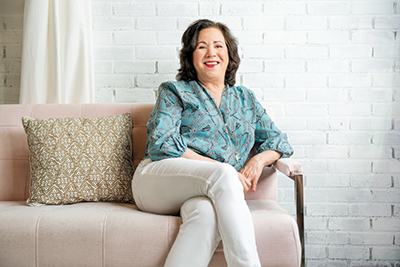
Phyllis Speen ’74
Photo: Webb Chappell
Phyllis Speen ’74
“When I came to Babson I didn’t really think about being one of few women. I wasn’t intimated by that. As women we just did what we wanted to do. A percentage of the guys at Babson came from all-male prep schools, and they weren’t sure how to treat women academically or even socially. They looked at you as a nuisance, usually not as dating material. And then there was a percentage that just were like brothers and would help you. The one thing you’ll hear from many women or men who were the first of something, was that we had the burden of having to succeed no matter what, because we were representative. For three-quarters of my career, I was usually the first or only woman in my role. I never knew not needing to succeed, because I was afraid it would be looked at as women couldn’t do it, versus Phyllis couldn’t do it.”
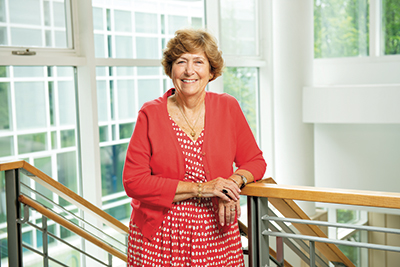
Anne McCormick Heller ’70
Photo: Webb Chappell
Anne McCormick Heller ’70
One of the first two women to earn undergraduate degrees
“There were only two of us in the undergraduate school. And there were no women faculty. There were no women in senior positions. There were no women’s sports. No clubs. I was working hard. It was competitive, but the male students treated me great. They were collegial and easy. I became part of campus life and was on student government. I had great professors. They made me totally comfortable in the classroom.”
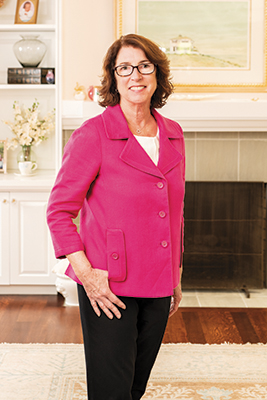
Ellen Monahan Saliba ’74, MBA’80
Photo: Winni Wintermeyer
Ellen Monahan Saliba ’74, MBA’80
“I entered Babson in September 1970. That was the pivotal point. Prior to that, there were a few women. But that September, they admitted about 25. It was not pervasive, but there was an attitude of, what are these women doing here? That kind of stuff went away pretty quickly as they got to know us. We were there to get an education. I don’t think any of the women chose Babson to make a statement.
“We stuck together. To walk into Trim Dining Hall, it was uncomfortable at times. We felt we were very visible, so we would gather at 5:30 in the dorm and walk over together. The women were such a good support structure. We were allowed to put our mark on the school by being leaders on the newspaper, yearbook, student government. I got a great education. I was so well-prepared for life and for working in a world that is male dominated.”
The Pioneers’ Words of Wisdom
Ellen Monahan Saliba:
“Life is long. Keep going. Don’t let a roadblock slow you down from what you want to do.”
Anne McCormick Heller:
“It’s a global world. Take advantage of the international population at the undergrad and grad school. Meet these folks.”
Carolyn Levosky:
“If you’re competent and really know what you’re doing, when you’re speaking to someone, they’re going to listen to you. It doesn’t matter if you’re a man or a woman. If you have credibility, that makes a huge difference.”
Sharon Rowser:
“We’ve made strides, both racially and genderwise, but we still have to pay attention, because discrimination has not gone away.”
Phyllis Speen:
“If you’re in sales, know your audience and talk in terms of their world. Selling is a skill. It’s about listening, asking questions, and understanding someone’s perspective. We should really change the word ‘sales’ to ‘communication’.”
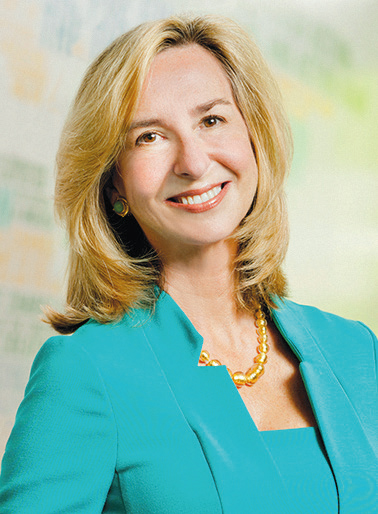
President Kerry Healey
Photo: Webb Chappell
As my time at Babson soon comes to a close, it prompted me to consider how the College has grown and evolved over the past six years. I am exceedingly proud of our record of shared accomplishments and the impact the Babson community is making around the world.
On campus, over the last six years, we have welcomed the most well-qualified, diverse, and international undergraduates in Babson history, including 47 Global Scholars and the first female-majority class. We launched an accelerated degree pathway to reduce undergraduate tuition by up to 25 percent, met 100 percent of demonstrated need for incoming undergraduates, and awarded nearly $200 million in grants and scholarships since 2013.
We have celebrated the renovation and expansion of the Park Manor Quad, and opened Roger’s Pub & Grille and the Weissman Foundry. We created new spaces for wellness and connection with the Babson Recreation and Athletics Complex and Babson Commons at Horn Library. And, we restored and relocated the Babson Globe to a beautiful new park at the center of campus—one that will be named in my honor, as Kerry Murphy Healey Park. My most sincere thanks to everyone who has made this possible.
Around the world, Babson’s reach and reputation are unparalleled. Since 2015, we have introduced new satellite locations, launched the Babson Collaborative for Entrepreneurship Education, and brought free, online courses to nearly 200,000 students in more than 200 countries. Since 2013, alumni participation has increased 135 percent, international giving has increased 500 percent, and we have raised nearly $200 million to support Babson’s people, programs, and campus.
We have achieved so much together, yet there remains an incredible need and opportunity for Babson to lead in our second century. Babson has always believed that business can be a force for good, that it can transform lives, communities, and societies for the better. In the words of Roger Babson, business should be “a means of rendering service to humanity.”
Today, more than ever, the world needs entrepreneurs. Without question, Babson’s entrepreneurs possess the skills, ambition, and mindset to take on big challenges and change the world.
Thank you for allowing me to lead this remarkable institution. I am so grateful to be a member of this extraordinary community and I cannot wait to see what the future holds for Babson.

Kerry Healey
]]>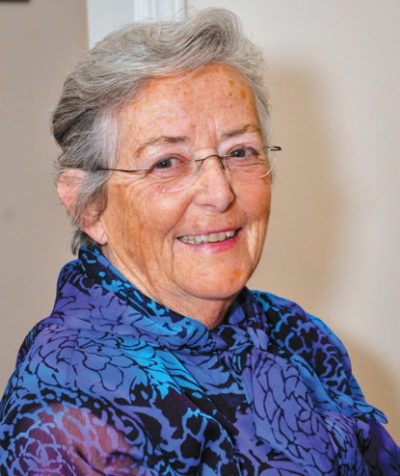
Cecily (Cis) McClatchy Glavin, H’97
Photo: Patti Glavin O’Mara
Cecily (Cis) McClatchy Glavin, H’97, wife of Babson College’s ninth president William Glavin, H’99, died unexpectedly February 4, age 85. Cis was involved with many charitable organizations and served on various boards, including The American School in London, The American School in London Foundation, and New York City-based Lighthouse Guild and Elder Craftsman. She also was instrumental in raising funds and helping to design the Glavin Family Chapel on the Babson campus. Cis received an honorary doctorate degree from Babson in 1997 and was the undergraduate class Commencement speaker the same year. She is survived by her husband and 41 family members.
]]>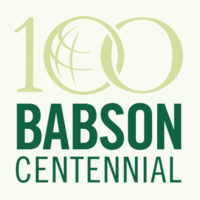
“During the year, we will share important new research, advance our strategic goals related to family enterprises and women entrepreneurs, and create social and economic value around the world,” says President Kerry Healey. “We will both honor our past and leverage this historic moment to prepare Babson for its next century.”
Among those preparations is the transformation of Babson’s main campus through four major projects: the recently dedicated Weissman Foundry and the Babson Recreation and Athletics Center, the Babson Commons at Horn Library, and Centennial Park, all three of which will be completed in 2019.
This fall, members of the College community nominated their most memorable Babson people, moments, and places for inclusion in the Babson100, a list to be revealed and celebrated in 2019.
The first major Centennial event is a February 8 fireside chat with President Healey and six of her predecessors, followed by a President’s Gala for students, faculty, staff, and alumni.
Also, mark your calendar for the September 18-22 Centennial Celebration, which will bring three signature events together on campus: Babson Connect: Worldwide; the Academy of Distinguished Entrepreneurs; and Back to Babson.
Visit www.babson.edu/centennial to learn more.—Andy Tiedemann
]]>The Commons also will be home to the new and expanded Stephen D. Cutler Center for Investments and Finance, raising the profile of finance at Babson and allowing the Finance Division to expand its curriculum and signature learning experiences.
Babson Commons at Horn Library is one of several large capital projects underway in celebration of the College’s Centennial. At a groundbreaking ceremony for the Commons in May, President Kerry Healey said, “As we approach our Centennial, Babson is transforming our campus for the next 100 years. This project will expand opportunities for academic, cocurricular, and social interactions and create a central gathering place where our entire community can collaborate and connect.”

Illustration: Dongik Lee
Throughout the summer months and into the fall, heavy construction machinery first demolished the old brick patio in front of the library’s main entrance, then began excavating the new structure’s foundation. Meanwhile, unflappable students accessed the building through the computer center or Gerber Hall. The disruptions will undoubtedly prove worthwhile in the end, when the new Commons opens in May 2019. —Jane Dornbusch
]]>As part of its restoration, the Globe eventually will be relocated to a more significant position on campus: Centennial Park, which is currently under construction. The park and restoration project are being funded by the generosity of trustee Robert Weissman ’64, H’94, P’87, ’90, and his wife, Jan, P’87, ’90. Centennial Park will be on College Drive, across from Hollister Hall and the Reynolds Campus Center, and the Globe, along with flags that represent the 80-plus countries with ties to Babson, will serve as its centerpiece.
President Kerry Healey had a vision for bringing these two symbols of Babson’s global presence and diversity into one central location, says David Grissino, director of capital projects and planning at Babson. “This will put the Globe in a much more prominent place on campus, so it becomes part of everyday life for students, visitors, faculty, and staff,” he says.
Founder Roger Babson commissioned the Globe in 1947 to stimulate interest in the world among students and visitors. Dedicated in 1955, it was positioned next to Coleman Hall to create what was then known as The Map and Globe Museum, with Coleman housing a 65-foot plaster relief map of the contiguous 48 states (removed in 1998). The intention was to enclose the Globe to protect its structure and mechanics, but this never came to pass. Nonetheless, the Globe, which used to spin and rotate, drew thousands of visitors to campus. Exposed to weather, however, it eventually began to degrade. By the 1980s, the Globe had rusted and failed. Although restored in the early 1990s, it has since deteriorated again.
Babson’s pending Centennial and the multiple construction projects transforming campus spurred the idea for Centennial Park, says Grissino, who adds that before the Globe can be restored fully, it must be moved to its new location. The Globe has two main components, he explains: the physical structure of the globe, and the mechanics that sit underneath it in a bunker. Ideally, during next winter the bunker will be constructed and the mechanics restored, and then the Globe will be put in place. Next would come restoring the Globe’s surface, during which the project would be enclosed to create a temperature-controlled environment.
Plans include making the Globe spin again and improving on its original design to allow for exposure to the elements. “In the last restoration, a vinyl sheet was applied to the surface of the Globe, and the ravages of time and solar exposure caused it to fade,” Grissino says. “So we’re working with a company that specializes in exterior painting. If we paint directly on the Globe, it gives us a lot more flexibility to do repairs. We wouldn’t be in a repeated maintenance cycle, which would be costly and disruptive.”
If all goes according to plan, the Globe and Centennial Park, which also will include a life-size bronze statue of Roger Babson and markers celebrating the College’s 100-year history, will be ready for visitors next spring. Meeting this goal means overcoming huge challenges and tight deadlines, but the team behind Centennial Park is not daunted. “The Globe is a unique object, and this is also a unique time in the school’s history. It’s meaningful to a lot of people that we’re part of a trajectory here as the campus celebrates,” Grissino says. He adds: “We’re moving the world.”—Donna Coco
]]>
Photo: Webb Chappell
FEI director Caroline Daniels (center) with members (from left) Marcella Urso, Chad Caisse, Carrie Hecker, and Shu-Ning Hsu, all MBA’18
Caroline Daniels, senior lecturer in entrepreneurship, became aware of a pent-up demand for fashion and apparel education in the spring of 2016, when she taught a class on future trends. Given an open-ended assignment to study an industry, a good third of the class chose to focus on fashion. Encouraged by their enthusiasm, Daniels—supported by a few grad students—put together a “fashion discussion table” on campus that fall to gauge interest.
“We expected maybe 30 people,” says Daniels. “Eighty showed up.” Thus was born the Fashion Entrepreneurial Initiative. FEI brings in high-profile speakers and has hosted numerous events on campus, ranging from a student fashion show to an annual “Future of Fashion” panel. This past winter, FEI partnered with the Digital Experience Initiative, the Babson Marketing Club, and the Babson IoT Club for a two-day “Imagine-a-Thon,” in which teams of students worked to “re-create the theme park experience for the home.” Nigel Simpson, director of tech strategy for The Walt Disney Co., served as one of the judges. Then in April, the group hosted an action tank to discuss environmental challenges facing the fashion industry with Kathryn Hilderbrand, founder and CEO of Good Clothing Co.
Clearly, the group’s brief is broad. But the push toward fashion at Babson is about much more than style. Students, who largely drive the FEI agenda, are interested in all aspects of the apparel industry, from production to labor practices to sustainability to retail and distribution models. “One of our main goals,” says Carrie Hecker, MBA’18, “is to let undergrads and grads know there are many other areas of fashion they can get involved in.”
February’s Imagine-a-Thon aptly demonstrated the breadth of FEI’s mission. Student teams had 24 hours to come up with a project and a prototype; the winner posited a “magic box” that could enhance the experience of streaming videos by adding such ambient effects as wind, fog, flashing lights, and aromas. Fun, but is it fashion? “The question really was about all the sensory elements that add up to Disney, and that very much does include fashion,” says Chad Caisse, MBA’18, an FEI member who participated in the event. “The princess costumes alone are huge.”
FEI also looks at fashion through a more conventional design lens. Its members are excited about the Weissman Foundry, currently under construction on campus, which will provide resources for hands-on projects; Daniels and the FEI team worked to ensure that the new makerspace includes a fashion room where students can hone their fabricating skills. But iconoclasm and disruption are baked into the idea of FEI. “What the fashion industry needs,” says Caisse, “are people who question the fashion industry—question its schedule and its process and its ideals and bring it into a new age. And I think there is the brain power here at Babson to do that.”
FEI was created, at least in part, to help disseminate that message. Says Daniels: “We’re building toward leading-edge education experiences around fashion business models. We’re going to show the world that we have a global fashion community.”—Jane Dornbusch
]]>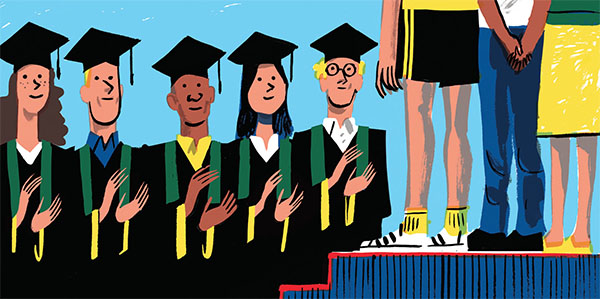
Illustration: Joao Fazenda
One person at Babson who inspired me was Shatiek Gatlin ’16. He saw my potential before I did. He was the president of the Black Student Union, and he asked me to be the vice president of marketing. He also tutored me. We usually met in Reynolds to do work, and he helped me with some of my most stressful classes. Most importantly, he was a friend and mentor. He got me through some tough life situations. He let me cry on his shoulder when times were unbearable, and then he wiped my tears and pushed me back out into this scary world. He gave me the confidence and tools to realize that I am enough, and that I am destined for greatness.—Caitlyn Pobee ’18
At Babson, you’ll be inspired on most days, whether by professors or classmates. But occasionally during stressful times, when finals are approaching or a presentation is due, inspiration can be hard to find.
For the past two years, though, I’ve been inspired without fail by the Olin Cafe staff. Sometimes it’s Jenny or Carmen, sometimes it’s Alejandro. I’m at the cafe every day, sometimes more than once, and they always have a smile, a word of encouragement, and easy banter that lets you know they care. The world is a brighter, happier place thanks to them.—Saachi Singh, MBA’18
Multiple people inspired me at Babson, but if I have to choose one, I would pick Dwight Gertz, senior lecturer in management. He was my professor for my BCAP consulting project and my decisions class. His thoughtfulness and perspective helped me to think differently.
One thing in particular I will never forget about him: his ability to see the world and view global business as something simple and achievable. He inspired me to set bigger and more ambitious goals for my career. At Babson I launched Waku, a food and beverage company sharing healthy traditions from the Andes Mountains in Ecuador. It was conceived as a global brand since its first day, and professor Gertz inspired me to pursue that goal with even more confidence.—Juan Giraldo, MBA’18
My coach, Julie Ryan, along with all of my field hockey teammates, especially my four fellow seniors, have cheered me on since my first day at Babson. Being part of the team pushed me to work harder and inspired me to set higher goals for myself both on and off the field.
My senior teammates and I have grown together over our four years here, and I can’t thank them enough for motivating and supporting me every step of the way. This team has made my college career into an experience that I wouldn’t trade for anything.—Jessica Kelley ’18
]]>